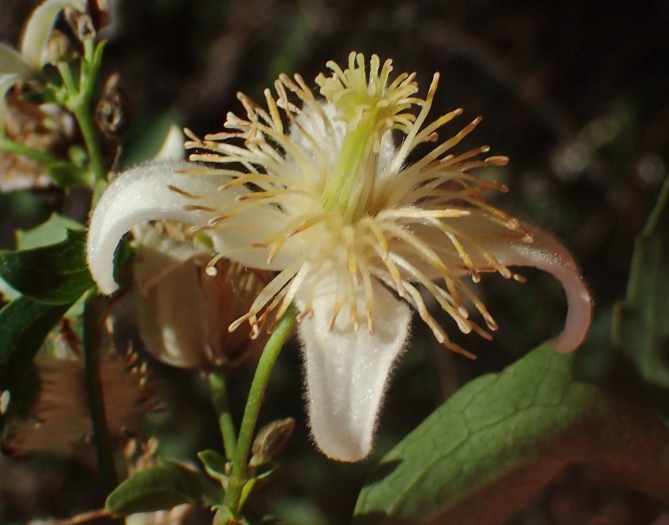Traveler’s-Joy
(Clematis brachiata)
Traveler’s-Joy (Clematis brachiata)
/
/

Nicola van Berkel
CC BY-SA 4.0
Image By:
Nicola van Berkel
Recorded By:
Copyright:
CC BY-SA 4.0
Copyright Notice:
Photo by: Nicola van Berkel | License Type: CC BY-SA 4.0 | License URL: http://creativecommons.org/licenses/by-sa/4.0/ | Rights Holder: Nicola van Berkel | Publisher: iNaturalist | Date Created: 2021-03-28T09:48:41-07:00 |























































Estimated Native Range
Summary
Clematis brachiata, commonly known as Traveler’s-Joy, is a deciduous perennial vine native to a variety of habitats in Sub-Saharan Africa, including forest margins, scrublands, and along riverbanks. It can grow to a height of 6-9 feet and a width of 4-6 feet, often using trees and shrubs as support to reach sunlight. The leaves are pinnate, with 1 to 7 leaflets, and the plant produces clusters of fragrant white to cream flowers, which are particularly showy during the summer and fall seasons.
Traveler’s-Joy is valued for its fragrant and attractive flowers, which can add a wild, naturalistic feel to gardens. It is often used to cover trellises, pergolas, and fences, and can be a good choice for creating vertical interest in a garden setting. This vine prefers full sun but can tolerate part shade, and it requires medium amounts of water with well-drained soil to thrive. While it is generally easy to maintain, it can be susceptible to clematis wilt, a fungal disease that causes sudden wilting and death of the plant. Additionally, Clematis brachiata is known to be potentially invasive outside its native range, so gardeners should consult local regulations before planting.CC BY-SA 4.0
Traveler’s-Joy is valued for its fragrant and attractive flowers, which can add a wild, naturalistic feel to gardens. It is often used to cover trellises, pergolas, and fences, and can be a good choice for creating vertical interest in a garden setting. This vine prefers full sun but can tolerate part shade, and it requires medium amounts of water with well-drained soil to thrive. While it is generally easy to maintain, it can be susceptible to clematis wilt, a fungal disease that causes sudden wilting and death of the plant. Additionally, Clematis brachiata is known to be potentially invasive outside its native range, so gardeners should consult local regulations before planting.CC BY-SA 4.0
Plant Description
- Plant Type: Vine
- Height: 6-9 feet
- Width: 4-6 feet
- Growth Rate: Moderate
- Flower Color: White, Cream
- Flowering Season: Summer, Fall
- Leaf Retention: Deciduous
Growth Requirements
- Sun: Full Sun
- Water: Medium
- Drainage: Medium
Common Uses
Bank Stabilization, Bee Garden, Bird Garden, Butterfly Garden, Deer Resistant, Drought Tolerant, Fragrant, Hummingbird Garden, Rabbit Resistant
Natural Habitat
Native to a variety of habitats in Sub-Saharan Africa, including forest margins, scrublands, and along riverbanks
Other Names
Common Names:
Scientific Names: Clematis orientalis , Clematis hirsuta , Clematis simensis , Clematis brachiata , Clematis hirsuta var. dolichopoda , Clematis tibestica , Clematis brachiata var. burkei , Clematis burgensis , Clematis friesiorum , Clematis kerrii
GBIF Accepted Name: Clematis brachiata Thunb.